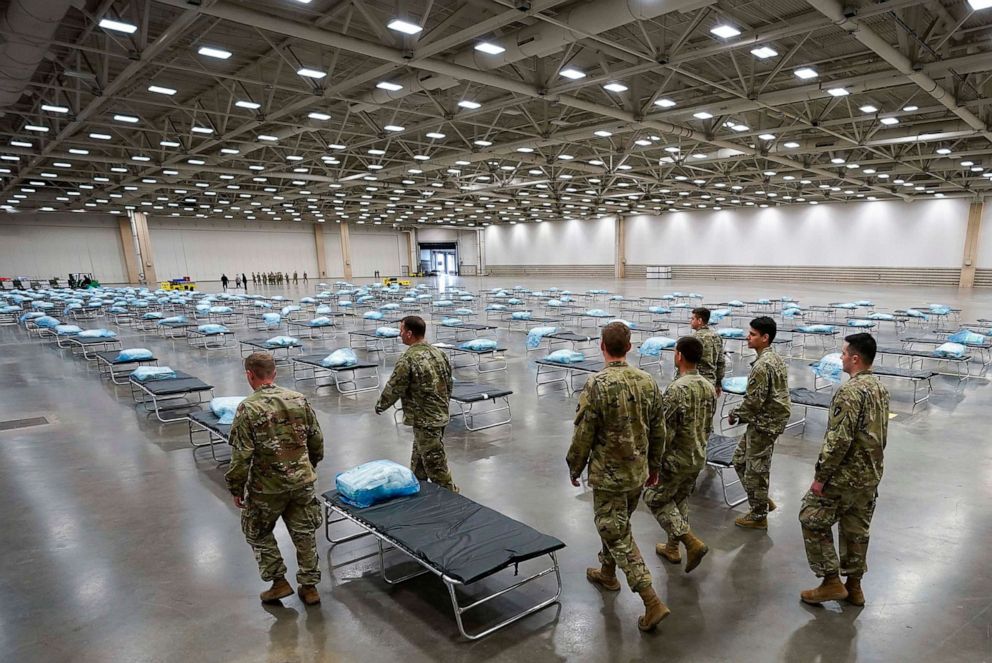As officials push reopening, schools that served as temporary hospitals are stuck in the middle
"I can't see many situations where we could have both," one official said.
In the early days of the pandemic when Michigan saw the coronavirus' relentless spread, Grand Valley State University converted one of its campus buildings to a 250-bed temporary overflow hospital.
The site never took in any patients and was later broken down, but with cases rising again across much of the country, the school has already been notified that it may be needed once again as the possibility of a local resurgence looms.
Now there's problem: The university is planning to reopen its doors to some of its 25,000 students in the fall, without an active field hospital on campus.
"So we are having a meeting this week to discuss how could this look if indeed another surge occurs again," said Jean Nagelkerk, the university's Vice Provost for Health, explaining the university is trying to determine how the two could coexist, if at all. "We want to make sure that everyone's needs are taken into consideration, so this is great to look at all the different options that we have.”
What to know about coronavirus:
- How it started and how to protect yourself: Coronavirus explained
- What to do if you have symptoms: Coronavirus symptoms
- Tracking the spread in the U.S. and worldwide: Coronavirus map
Coronavirus infections have reached new levels in the pandemic and hospitalizations are up in 40 states, according to an ABC News analysis, threatening hospital capacities in some areas. In Florida, for instance, 50 intensive care units currently have no beds available, according to the state's health department.
And while some, including President Trump, are clamoring to reopen schools in the fall, officials at several institutions from universities to local high schools who converted facilities to hospital overflow locations earlier in the crisis told ABC News they are still actively preparing for the possibility that their spaces may once again be needed in the fall, when experts say the pandemic is likely to collide with the flu season and exasperate the problem.
The Nashua County School District in New Hampshire is more clear on the issue: a high school that the county set up as a field hospital in the spring will be put back into operation as a hospital if needed, Stacy Hynes, the spokesperson for the district, told ABC News.
Administrators there largely recognize that the space can't function as both a school and a hospital, but emphasize it shouldn't have to be -- if the outbreak is so bad that hospitals are overflowing, in-person school should be cancelled anyway, said Shawn Smith, the Director of Plant Operations for the Nashua School District.
"In the event we needed [the school] as an alternative care site I can't see many situations where we could have both set up," Smith said. "The conditions would likely be far worse to require it to be set up. I also don't think parents and guardians would be willing to send kids to a location being used for that at the same time anyway."

It’s unclear how many schools across the country previously converted their facilities. A spokesperson for the federal Department of Education referred ABC News to state and local officials when asked for a national count.
Ulster County in New York, which has largely crushed its outbreak, set up a 100-bed field hospital at a local high school in the spring and is already working to identify other locations to use should the need arise, Ulster County Executive Pat Ryan told ABC News on Monday. The county experienced significant resource shortages early on and does not want to be caught in the same situation: they were down to just one ventilator for its 200,000 residents back in April.
"I've tried to be very transparent and open with the public that I think its very likely we will still have some resurgence, because that's what every single public health expert says," Ryan said.
"There is a lot of contingency planning with our hospitals, if we need to stand up the high school potentially if needed, have the auditorium," he continued. "Its not our primary location, its our third option at this point."
But some school administrators have shut the door on the possibility of re-offering their services in the same capacity they did in the spring as they plan to welcome students back in just a matter of weeks. Tufts University in Massachusetts made space in their residences for recovering patients and front-line workers, but said it needs the space back.
"The agreements with our community partners were written with the understanding that we would need to reclaim access to the residence halls by mid-summer to enable us to prepare them for the return of students," Patrick Collins, a spokesperson for Tufts told ABC News.
Middlebury College in Vermont, which went as far as to drain its ice hockey rink to make space, said it would still be willing to participate in some capacity, though not in the same manner as earlier on.
"At this time, we expect that most of our students will be returning. We would of course be willing to house staff from nearby Porter Medical Center, as we did earlier in the pandemic, and to offer the use of other spaces should the need arise," Sarah Ray, a spokesperson for the college, told ABC News. "This is a dynamic situation and, as always, we will work with our Porter colleagues to assist in any way we can if they need our support in the future.




